  |
|
|||
|
most recent update
|
||||
|
Swallow - Minsmere - May 2006 - ©Andrew Easton
|
This unfortunate Herring Gull was lying decapitated under the Ness
Point Carbon Cash Cow (a.k.a. wind turbine) on June 25th; just days after
the BBC News website carried the report from the RSPB that nine White-tailed
Eagles have been killed by wind turbines on the Smola islands off the
Norwegian coast in 10 months, including all of last year's chicks. In
addition breeding pairs at the site have fallen from 19 to just one. At
this rate there won't be any spare eaglets from Norway for English Nature
to release along the Suffolk coast.
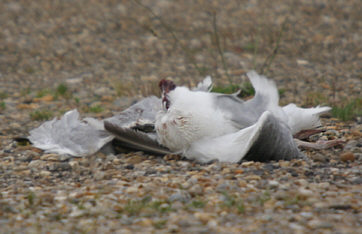
|
|
Decapitated
Herring Gull - under Ness Point wind turbine - June 2006
©Andrew Easton |
| Follow this link to the BBC News eagle story. This will open in a new window. |
RED-THROATED DIVER Gavia stellata
Kessingland - 4th (1 on sea), 6th (2 N).
GREAT NORTHERN DIVER Gavia immer
Two flew north together past Kessingland on the 16th.
DIVER
spp.
Kessingland - 2nd (a
distant large diver flew north).
GREAT CRESTED GREBE Podiceps cristatus
Kessingland - 3rd (1 o/s), 11th (1 o/s), 25th (2 S).
A pair with two well grown young were at Lound Waterworks on the 11th.
One was swimming north just offshore between Corton and Hopton on the
11th.
FULMAR Fulmarus glacialis
Kessingland - 1st (8 N, 1 S), 2nd (15 N), 3rd (32 N, 2 S),
4th (8 N, 1 S), 5th (9 N, 1 S), 6th (13 N, 1 S), 7th (1 N), 8th (5 N),
9th (5 N, 2 S), 10th (1 N, 2 S), 11th (1 S), 12th (1 S), 15th (2 N, 1
S), 16th (4 N, 1 S), 17th (2 N, 1 S), 18th (1 N), 19th (2 N), 21st (1
N, 1 S), 23rd (3 S), 24th (3 N, 3 S), 25th (2 N), 26th (4 N), 27th (6
N), 28th (2 N).
Ness Point - 3rd (1 N), 22nd (1 S), 24th (2 N).
Corton/Hopton - 11th (2 S).
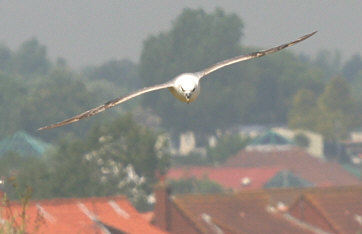
|
|
Fulmar
- Corton - June 2006
©Andrew Easton |
MANX SHEARWATER Puffinus puffinus
Three flew north together past Kessingland on the 16th, five flew north
past there on the 22nd, one north on the 26th and a further six flew north
together there on the 27th.
GANNET Morus bassanus
Kessingland - 1st (132 N, 6 S), 2nd (68 N, 4 S), 3rd (71
N, 5 S), 4th (18 N, 4 S), 5th (31 N, 7 S), 6th (25 N), 7th (44 N, 1 S),
8th (15 N, 16 S), 9th (16 N, 3 S), 10th (5 N, 3 S), 11th (21 N), 12th
(5 N), 13th (12 N, 2 S), 14th (7 N, 3 S), 15th (14 N, 13 S), 16th (73
N, 2 S), 17th (36 N, 1 S), 18th (6 N), 19th (14 N), 20th (3 N, 3 S), 21st
(22 N, 13 S), 22nd (44 N, 21 S), 23rd (38 N, 73 S), 24th (11 N, 17 S),
25th (14 N, 3 S), 26th (59 N, 8 S), 27th (65 N, 23 S), 28th (24 N, 11
S), 29th (32 N, 6 S), 30th (28 N).
Ness Point - 3rd (3 N), 24th (9 S), 30th (2 N).
CORMORANT Phalacrocorax carbo
Kessingland - 3rd (2 N), 4th (2 S, 1 o/s), 6th (1 S), 8th
(1 S), 10th (1 N, 1 S), 11th (6 S), 12th (2 N), 14th (1 S), 16th (1 S),
17th (3 S),
18th (1 S), 19th (1 S), 21st (1 S), 23rd (1 N, 1 S), 24th (3 N), 28th
(1 N), 29th (1 N).
Ness Point - 3rd (2 S).
Leathes Ham - 5th (14 roosting), 16th (13 roosting).
EUROPEAN SHAG Phalacrocorax aristotelis
One second summer/non breeding adult flew south past Ness Point on the
3rd. It was then seen in Hamilton Dock on the morning of the 4th, then
in the afternoon presumably the same individual was on the sea of Kessingland
before it flew off northwards towards Lowestoft.
LITTLE EGRET Egretta garzetta
One was at Burgh Castle on the 4th..
GREY HERON Ardea cinerea
One was at Corton new sewage works pond on the 4th.
One was at Leathes Ham on the 6th to 25th.
One was being mobbed by gulls as it flew south over Lake Lothing on the
9th.
MUTE SWAN Cygnus olor
Leathes Ham - 6th (14), 9th (8).
Oulton Broad - 6th (12), 9th (39).
WHITE-FRONTED GOOSE Anser albifrons
The diminutive individual with the damaged wing first noted in May 2003
was still at Oulton Broad on the 9th.
GREYLAG GOOSE Anser anser
Pair with three young at Leathes Ham on the 1st to 3rd.
Pair with five young were at Castle Marshes, North Cove on the 10th.
Two flew south over central Lowestoft on the 11th.
Oulton Broad - 6th (38), 9th (51 plus one Greylag x Canada
hybrid).
CANADA GOOSE Branta canadensis
Eight were on Oulton Broad on the 6th to 9th.
Ten were at Blundeston village pond on the 11th.
DARK-BELLIED BRENT GOOSE Branta bernicla bernicla
Two flew north past Kessingland on the 1st.
EGYPTIAN GOOSE Alopochen aegyptiacus
Two were at Barnards Meadow on the 5th.
Two were at Mutford Lock, Lake Lothing, on the 6th.
Oulton Broad - 9th (22).
Gunton Hall - 10th (pair with three young).
Lound village pond - 11th (pair with two young).
SHELDUCK Tadorna tadorna
Ness Point - 3rd (1 N).
Kessingland - 8th (3 S), 20th (1 S).
TEAL Anas crecca
Kessingland - 10th (2 S), 29th (4 S), 30th (16 S).
SHOVELER Anas clypeata
Leathes Ham - 7th (2), 8th (2), 9th (1), 21st (1).
TUFTED DUCK Aythya fuligula
Three flew south past Kessingland on the 18th.
COMMON SCOTER Melanitta nigra
Kessingland - 1st (2 S), 2nd (5 N, 38 S), 3rd (3 N), 4th
(20 N, 7 S), 5th (21 N), 6th (2 N), 7th (10 N), 8th (16 S), 9th (31 N),
11th (1 N, 2 S), 12th (15 N, 10 S), 14th (17 S), 15th (1 S), 16th (10
S), 17th (20 S), 19th (30 N, 1 S), 21st (11 N, 1 S), 22nd (1 S), 23rd
(35 N, 25 S), 24th (32 S), 25th (2 S), 26th (18 N, 62 S), 27th (16 N,
88 S), 28th (12 N), 29th (31 S), 30th (6 N, 15 S).
Ness Point - 24th (3 S).
HOBBY Falco subbuteo
One was seen over Wash Lane, Kessingland on the 2nd.
One was hunting Swifts over Normanston Park on the evening of the 6th.
One was seen over Hopton on the 11th.
Four were seen in the Ashby area on the 11th.
One was hunting over Castle Marshes, North Cove on the 10th.
GREY PARTRIDGE Perdix perdix
Two were at Corton new sewage works on the 14th and 18th.
QUAIL Coturnix coturnix
One was heard calling just to the west of the Beacon Park industrial estate
at Gorleston on the 3rd.
OYSTERCATCHER Haematopus ostralegus
Kessingland - 1st (5 N), 2nd (1 N), 4th (1 N), 5th (1 N),
7th (1 S), 8th (3 S), 9th (1 S), 11th (1 N, 3 S), 13th (4 N), 20th (1
N), 26th (1 S), 28th (2 N).
Hamilton Dock - 4th (1).
South Pier, Lowestoft - 7th (1).
RINGED PLOVER Charadrius hiaticula
Two were at Pakefield Beach on the 2nd.
Three were at Kessingland Beach on the 4th.
GREY PLOVER Pluvialis squatarola
Two flew north past Kessingland on the 3rd.
LAPWING Vanellus vanellus
One flew south-westwards over Gunton on the 12th. Presumably a failed
or non breeder.
KNOT Calidris canutus
Four flew north past Kessingland on the 3rd.
Three were on Breydon South Flats on the 18th.
SANDERLING Calidris alba
North Beach - 3rd (2 feeding along the shoreline), 9th (2
feeding along the shoreline).
Kessingland - 3rd (2 N, 1 on the beach).
Gorleston - 6th (1 on the beach).
Corton - 11th (7 S).
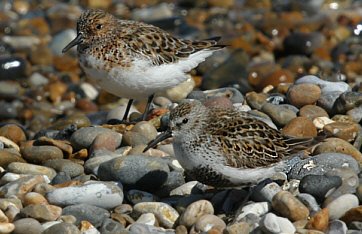
|
|
Sanderling
(top) & Dunlin - Kessingland - June 2006
©Andrew Easton |
DUNLIN Calidris alpina
Kessingland - 3rd (4 on the beach).
WHIMBREL Numenius phaeopus
Kessingland - 4th (1 N, 1 S), 15th (1 N), 18th (1 S).
CURLEW Numenius arquata
Kessingland - 10th (1 S), 15th (1 N), 17th (4 S),
18th (21 S), 19th (6 S), 20th (14 S), 23rd (2 S), 24th (15 S), 25th (5
S), 26th (16 S),
27th (1 S), 28th (3 S), 29th (25 S), 30th (3 S).
Ness Point - 24th (3 S), 30th (6 S).
Gunton Warren - 24th (7 S), 28th (1).
BLACK-TAILED GODWIT Limosa limosa
104 were on Breydon South Flats on the 18th.
BAR-TAILED GODWIT Limosa lapponica
One flew south past Kessingland on the 30th.
COMMON SANDPIPER Actitis hypoleucos
One was at Mutford Lock, Lake Lothing, on the 6th.
TURNSTONE Arenaria interpres
Ness Point - 3rd (1), 7th (3), 9th (8), 11th (6), 21st (2).
Kessingland - 1st (4 N), 4th (2 N), 6th (2 N), 8th (8 N).
Hamilton Dock - 29th (4).
ARCTIC SKUA Stercorarius parasiticus
One pale phase bird flew north past Kessingland on the 22nd. One flew
south on the 24th then settled on the sea.
GREAT SKUA Stercorarius skua
Single birds flew north past Kessingland on the 4th and 6th, with two
north on the 27th.
MEDITERRANEAN GULL Larus melanocephalus
Two adults flew south past Pakefield on the 2nd.
One second summer was on Breydon South Flats on the 18th.
Kessingland - 7th (1 first sum. on beach), 9th (1 2nd sum S),
10th (2 N), 11th (1 1st sum. N), 20th (2 adults S), 21st (1 2nd sum. S),
22nd (1 2nd sum. S), 24th (2 adults S), 29th (1 adult N).
LITTLE GULL Larus minutus
One first summer flew north past Kessingland on the 24th.
BLACK-HEADED GULL Larus ridibundus
The first juveniles of the year were noted off Kessingland on the
18th, and three were along the north beach at Lowestoft on the 23rd. They
had already found the scrap bins at the Birds Eye factory. One in particular
still had very rounded, still growing, primaries and was still struggling
even to fly properly!
KITTIWAKE Rissa tridactyla
Kessingland - 1st (20 N, 7 S), 2nd (25 N 5 S), 3rd
(25 N, 3 S), 4th (8 N, 4 S), 5th (14 N, 2 S), 6th (16 N), 7th (16 N, 2
S), 8th (7 N, 8 S), 9th (11 N, 15 S), 10th (1 N, 8 S), 11th (3 S), 12th
(10 S), 13th (4 N, 8 S), 14th (1 S), 15th (8 N, 4 S), 16th (13 N, 11 S),
17th (9 N, 11 S), 18th (7 N, 6 S), 19th (1 N), 20th (7 N, 18 S), 21st
(12 N, 30 S), 22nd (18 N, 33 S), 23rd (22 N, 50 S), 24th (16 N, 56 S),
25th (9 N, 8 S), 26th (1 N, 3 S), 27th (19 N, 37 S), 28th (10 N, 13 S),
29th (3 N, 13 S), 30th (8 N, 5 S).
High numbers of non breeding, mostly first summer, birds are hanging around
at Lowestoft at the moment, with a flock of 80+ flying
in from the north at 20:30 on the 29th.
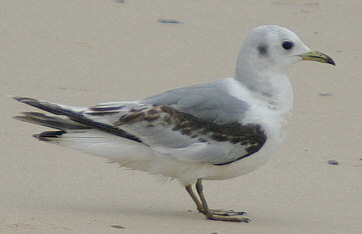
|
|
Kittiwake
(first summer) - Lowestoft - May 2006
©Andrew Easton |
SANDWICH TERN Sterna sandvichensis
Kessingland - 1st (15 N), 2nd (31 N), 3rd (5 N, 17 S), 4th (25 N, 3 S), 5th (14 N, 1 S), 6th (17 N, 7 S), 7th (37 N), 8th (25 N, 2 S), 9th (20 N, 3 S), 10th (11 N, 6 S), 11th (9 N, 3 S), 12th (24 N, 4 S), 13th (4 N), 14th (2 S), 15th (5 N, 2 S), 16th (18 N, 2 S), 17th (13 N), 18th (8 N, 3 S), 19th (14 N, 2 S), 20th (9 N, 6 S, 3 feeding), 21st (4 N, 17 S), 22nd (16 N, 5 S, 3 feeding), 23rd (18 N, 17 S), 24th (23 N, 23 S), 25th (15 N, 20 S), 26th (5 N, 20 S), 27th (13 N, 3 S), 28th (8 N, 8 S), 29th (11 N, 12 S), 30th (6 N).
Ness Point - 3rd (1 N), 23rd (2 S), 24th (3 N, 2 S), 30th (1 N).
Gunton Warren - 22nd (1).
COMMON TERN Sterna hirundo
Small numbers are seen and heard daily over north Lowestoft as they take a short cut between the breeding colony along Lake Lothing and the North Beach area.
Gunton Warren - 22nd (6).
'COMMIC' TERN Sterna hirundo/paradisaea
Kessingland - 1st (17 N, 1 S), 2nd (20 N, 2 S), 3rd (9 N), 4th (24 N, 16 S), 5th (25 N, 1 S), 6th (20 N, 16 S), 7th (6 N, 2 S), 8th (8 N, 13 S),
9th (6 N, 10 S), 10th (7 N, 3 S), 11th (7 N, 1 S), 12th (7 N, 3 S), 13th (5 N, 7 S), 14th (2 S), 15th (4 N, 3 S), 16th (7 N, 1 S), 17th (5 N), 18th (1 N), 19th (5 N), 20th (9 N, 9 S), 21st (2 N, 1 S, 1 feeding), 22nd (3 N, 1 S), 23rd (9 N, 4 S), 24th (16 N, 14 S), 25th (2 N, 4 S), 26th (1 N, 1 S), 27th (7 N, 4 S), 28th (2 N, 2 S), 29th (3 S), 30th (1 N, 3 S).
LITTLE TERN Sterna albifrons
Kessingland - 1st (37 N, 17 S), 2nd (26 N, 23 S), 3rd (21 N, 23 S, 40-50 feeding), 4th (28 N, 28 S, 40-50 feeding), 5th (38 N, 37 S, 40-50 feeding), 6th (33 N, 38 S, 25 feeding), 7th to 12th (25-30 feeding), 13th to 22nd (numbers dropped to 8-10 feeding), 23rd ( 4-5 feeding), 24th-28th (12-15 feeding), 29th (6-8 feeding), 30th (5 feeding).
Ness Point - 4th (2 S), 23rd (30+ feeding).
North Beach - 4th (6), 7th (4), 8th (34).
Corton/Hopton - 11th (26).
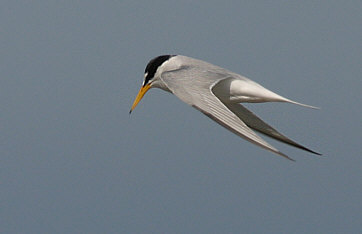
|
|
Little
Tern - Kessingland - June 2006
©Andrew Easton |
GUILLEMOT Uria aalge
One drifted south on the sea past Ness Point on the 24th.
AUK sp. Alcidae
Kessingland - 1st (1 N), 2nd (17 N), 3rd (13 N, 2 o/s), 4th (2 N, 1 S, 1 o/s), 5th (10 N, 1 S), 16th (1 S), 21st (2 N), 24th (2 N), 27th (2 N), 28th (1 N).
Ness Point - 24th (1 N, 1 S).
STOCK DOVE Columba oenas
Corton new sewage works - 4th (7), 14th (10).
Carlton Marshes - 9th (3).
RING-NECKED PARAKEET Psittacula krameri
The female Ring-necked Parakeet that was on a suet feeder in a garden in Hall Drive, Oulton Broad, on May 31st flew through the same garden on June 1st.
PARROT sp.
A small red headed and red breasted Parakeet with pale blue, yellow and black feathers on the wings and tail has been seen on and off in gardens in Cliftonville Road since the 24th. It was also seen over Kirkley Cemetery on the 28th. This description could fit an Eastern Rosella, which should have a white cheek patch in the red head and breast area if it is this species.
CUCKOO Cuculus canorus
One was calling at Kessingland on the 4th.
Two were on the Kessingland Levels on the 8th.
One was at Corton village football pitch on the 8th.
One was calling at Carlton Marshes on the 9th.
One was calling at Oulton Marshes on the 13th.
Four were seen and heard at Carlton Marshes on the 25th.
BARN OWL Tyto alba
One was at Beccles Marshes on the 16th.
At least three were seen at Carlton Marshes on the 25th, busily carrying food back to their young.
| Follow this link to find out more about the Suffolk Community Barn Owl project. It aims to reverse the fortunes of the Barn Owl in Suffolk by the provision of nest boxes. This will open in a new window. |
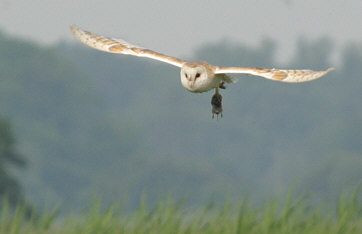
|
|
Barn
Owl (and Vole dinner) - Carlton Marshes - June 2006
©Andrew Easton |
LITTLE OWL Athene noctua
One was near Corton new sewage works on the 18th and 24th.
KINGFISHER Alcedo atthis
At least one was seen and heard calling at Gunton Hall lake on the 3rd and 10th.
At least one was heard calling at Leathes Ham on the 16th.
One was at Beccles Marshes on the 16th.
One was seen at Carlton Marshes on the 25th.
GREEN WOODPECKER Picus viridis
One was seen at Gunton Hall lake on the 3rd.
One was at Mutford Lock, Lake Lothing, on the 6th.
One flew south over Bloodmoor Road, Pakefield on the 8th. A brief distraction from sitting in the roadwork traffic.
Two were seen at Black Street, Kessingland on the 9th.
Several were seen at Oulton Marshes on the 13th.
One was at Gunton Warren on the 22nd and 30th.
SWALLOW Hirundo rustica
Ness Point - 3rd (3 N).
HOUSE MARTIN Delichon urbica
Ness Point - 3rd (3 N.
YELLOW WAGTAIL Motacilla flava flavissima
One was seen at Carlton Marshes on the 9th.
Two were seen at Gisleham on the 9th.
One was seen near Corton old sewage works on the 11th.
Two were seen at Carlton Marshes on the 25th.
One was at Corton new sewage works on the 25th.
BLACK REDSTART Phoenicurus ochruros
One young male was singing at Hamilton Dock the 4th to 8th.
One male was signing in Belvedere Road, Lowestoft on the 6th.
One young male was singing at Ness Point on the 11th.
WHEATEAR Oenanthe oenanthe
North Denes (Camp site) - 3rd (2 females), 4th (1 male), 8th (1 immature male).
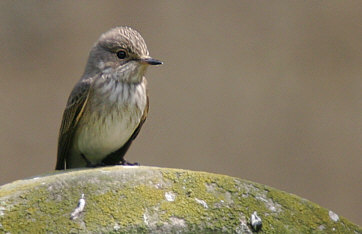
|
|
Spotted
Flycatcher - Carlton Colville - June 2006
©Andrew Easton |
CETTI'S WARBLER Cettia cetti
Burgh Castle - 4th (1 singing).
Lound Waterworks - 4th (1 singing), 11th (1 singing).
Kessingland Levels - 8th (2 singing).
GRASSHOPPER WARBLER Locustella naevia
One was singing at Oulton Marshes on the 13th.
Three were singing at Carlton Marshes on the 25th.
SEDGE WARBLER Acrocephalus schoenobaenus
One was singing along the disused railtrack at Gunton on the 4th.
LESSER WHITETHROAT Sylvia curruca
Two were singing along Millennium Way, Lowestoft on the 3rd and 10th.
Two were singing at the orchid meadow at Gunton on the 3rd.
One was singing along the disused railtrack at Corton on the 3rd, 8th and 11th.
COMMON WHITETHROAT Sylvia communis
Gunton Warren - 22nd (5), 28th (8).
CHIFFCHAFF Phylloscopus collybita
Gunton Warren - 22nd (1).
WILLOW WARBLER Phylloscopus trochilus
Gunton Warren - 22nd (1), 28th (1).
SPOTTED FLYCATCHER Muscicapa striata
A pair were at Hedley House, Carlton Colville on the 1st.
A pair have also returned to nearby St. Peter's Church at Carlton Colville.
Apparently no sign at Gunton Hall lake so far, but the regular nest stump has decayed and fallen off, so they may have moved away from the regular spot.

|
|
Hooded
Crow x Carrion Crow hybrid - Burgh Castle - June 2006
©Andrew Easton |
HOODED CROW x CARRION CROW Corvus
cornix x
Corvus corone
One of the resident hybrids was showing well in the grounds of Burgh Castle
on the 4th and 8th.
SERIN Serinus
serinus
One put in a brief appearance in a Kessingland garden on
the 2nd.
GREENFINCH Carduelis chloris
Gunton Warren - 22nd (2), 28th (4).
GOLDFINCH Carduelis carduelis
Gunton Warren - 28th (1).
LINNET Carduelis cannabina
Gunton Warren - 22nd (13), 28th (14).
CROSSBILL Loxia
curvirostra
At least 40 were seen in the Waveney Forest at Fritton
on the 3rd.
BULLFINCH Pyrrhula
pyrrhula
A pair were seen at Gunton Hall on the 17th.
A pair were seen at Carlton Marshes on the 25th.
YELLOWHAMMER
Emberiza citrinella
One male was seen at Rushmere on the 9th.
At least three were seen and heard in the Ashby area on
the 11th.
Gunton
Warren - 22nd (3 singing males), 28th (6).
WEAVER FINCHES
One escaped male, probably of one of the black headed races of Village
Weaver Ploceus cucullatus judging by the photo and description,
was adding a splash of colour to gardens on the Whitton estate on the
19th.
In addition the Lowestoft Journal of June 30th reports that a Red-billed
Quelea Quelea
quelea is being
seen with House Sparrows in an Oulton Broad garden.
NON-BIRD NEWS
Harbour Porpoise
Kessingland - 1st (1 S), 4th (1 N), 16th (1 S), 21st (2 N).
Grey Seal
Kessingland - 1st (1), 6th (1), 16th (1), 17th (2), 20th (1), 22nd
(1), 23rd (1), 27th (1), 28th (1).
Corton - 11th (1).
Ness Point - 24th (2).
Two Green Hairstreak butterflies are being seen regularly along
the disused railtrack at Corton, up to the 8th at least. Despite searches
of the much more extensive areas of Gorse at Gunton Warren there don't
appear to be any there!
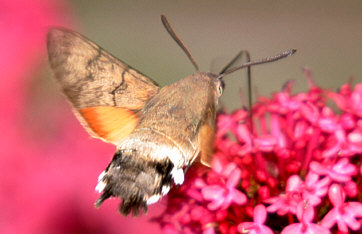
|
|
Hummingbird
Hawk-moth - Lowestoft - June 2006
©Andrew Easton |
Whilst
bird migration is winding down, migrant butterflies and moths are now
appearing. On the 11th several Painted Lady butterflies were around
the area and the first few Silver Y moths were also about. Also
on the 11th single Hummingbird Hawk-moths were seen in gardens
in Kessingland and St. Olaves. Two Hummingbird Hawk-moths were
seen together in gardens in Kessingland and in Stevens Street, Lowestoft
on the 13th. Singletons were again present at Kessingland on the 14th
to 27th (with two on the 21st), intermittently at St. Olaves until the
8th at least, and two reappeared in Stevens Street on the 15th. All were
feeding at Red Valerian.
Others singletons were seen at Parkhill on the 14th, 16th, 18th and 23rd
(feeding at Honeysuckle); Gunton on the 14th, Oulton Broad on the 15th
and Elm Tree Road on the 24th. Four were seen at Flixton Nebb/Blundeston
Marshes on the 22nd.
A Broad-bordered Bee Hawk-moth was seen at Blundeston on the 18th.
Dragonfly wise good numbers of Scarce Chaser were around Castle
Marshes, North Cove on the 10th, along with a few Norfolk Hawkers
and Hairy Dragonflies.
Just outside our area in Norfolk a Lesser Emperor was seen along
Haddiscoe Cut on the 18th and 20th. On the 23rd two male Red-veined
Darters were seen at the Corton new sewage works pond. On the 24th
at least 10-12 were present including three pairs egg laying. At least
two males were present on the 25th but the weather was much cooler and
dragonfly activity was much reduced.
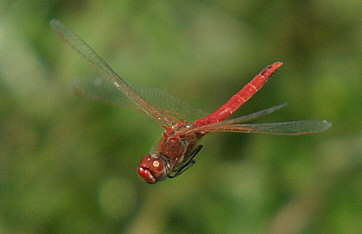
|
|
Red-veined
Darter - Corton - June 2006
©Andrew Easton |